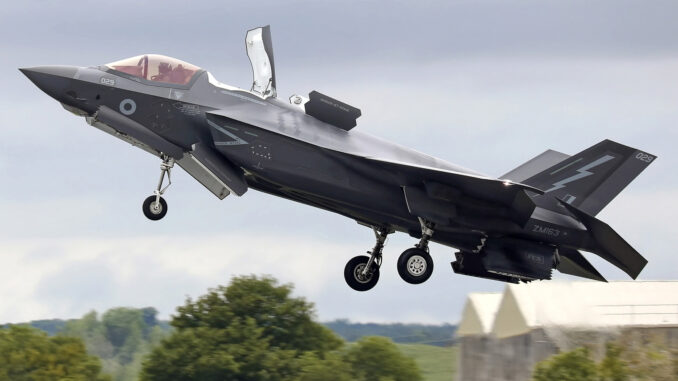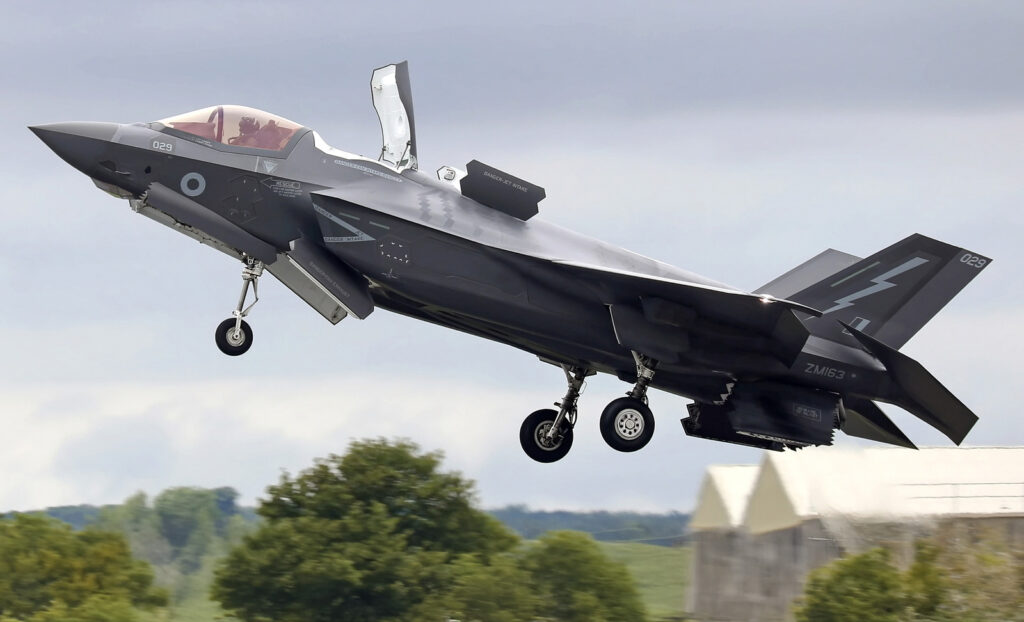
An analysis of the budgetary challenges threatening the UK’s F-35B programme and the potential impact on the development of the Tempest fighter.
The UK faces a crucial dilemma: whether to continue acquiring the F-35B, the fifth-generation fighter aircraft essential to its defence, or to concentrate on developing the future Tempest fighter, an ambitious national project. Budgetary constraints could force the government to reduce the number of F-35Bs, jeopardising the effectiveness of its air fleet and the credibility of its air defence capability. This article explores the financial, strategic and operational issues surrounding this critical decision.
The strategic importance of the F-35B to UK defence
The F-35B Lightning II is a fifth-generation fighter aircraft with short take-off and vertical landing (STOVL) capabilities, designed to operate from aircraft carriers and land bases. In the UK, it is the cornerstone of air power on Queen Elizabeth class aircraft carriers. With a unit cost of around €78 million, the F-35B is not only a significant investment, but also a major strategic asset for the Royal Air Force (RAF) and the Royal Navy.
The F-35B’s capabilities include advanced stealth, integrated sensor systems and the ability to engage air and ground targets with unprecedented precision. These features make it an indispensable tool for air superiority and strategic interdiction missions, both at sea and on land. In addition, the F-35B is designed to operate in conjunction with other modern weapons systems, enhancing the UK’s ability to conduct complex military operations.
However, despite its strengths, the UK’s F-35B programme is currently under pressure due to budgetary constraints. The government has so far ordered 48 of the 138 aircraft originally planned, but there are still uncertainties about whether it will be possible to finance the entire fleet. The high cost of the F-35B, combined with the challenges of integrating it with new weapons technologies, raises questions about the long-term viability of the programme.
Financial challenges threatening the full acquisition of the F-35B
The UK is facing a budget deficit estimated at €29 billion, inherited from the previous Conservative government. This difficult economic context presents Sir Keir Starmer’s government with a delicate choice: to stay the course on the F-35B acquisition or redirect funds towards domestic projects such as the sixth-generation Tempest fighter.
The F-35B is not only expensive to buy, but also to operate and maintain. The average operational cost per flying hour is estimated at €35,000, making the F-35B one of the most expensive fighter aircraft to operate. This reality, coupled with rising maintenance costs, has led to a reassessment of the feasibility of continuing the F-35B programme on a large scale.
At the same time, the development of the Tempest, a sixth-generation fighter expected to be operational by 2035, represents a strategic investment for the UK. This project, carried out in collaboration with Italy and Japan, aims to maintain the UK’s sovereignty in the design and production of advanced fighter aircraft. The Tempest promises to incorporate advanced stealth technologies, next-generation weapons systems and autonomous UAVs, while offering greater flexibility in weapons integration.
Competition for resources between these two fighter programmes could force the government to scale back its ambitions for one or both of them. This poses a strategic dilemma for the UK, which must choose between maintaining an immediate defence capability with the F-35B or investing in a technological future with the Tempest.

The consequences of a reduction in the F-35B fleet
A reduction in the F-35B fleet would have major consequences for the UK’s power projection capability, particularly at sea. The aircraft carriers HMS Queen Elizabeth and HMS Prince of Wales, which cost around €7.2 billion**, are designed to operate with a full fleet of F-35Bs. A reduced fleet would compromise the effectiveness of the UK’s naval air groups, limiting their ability to conduct global air superiority and strategic strike operations.
In addition, a reduced F-35B fleet could also affect the UK’s ability to meet its international commitments, particularly within NATO. The F-35B plays a crucial role in air policing missions, such as those in Iceland, and in combat operations, such as those against the Islamic State in Iraq and Syria. Reducing the fleet could weaken the UK’s defence posture and reduce its ability to respond quickly to global threats.
Reducing the F-35B fleet could also have an impact on the UK defence industry. The F-35 programme generates jobs and supports a complex supply chain that benefits many UK companies. A reduction in the programme could lead to a reduction in investment in this sector, with significant economic and social consequences.
Tempest: a more sustainable alternative for the future?
The Tempest is presented as the next step in the evolution of the UK Air Force, offering a sustainable alternative to the F-35B. Unlike the F-35, Tempest is designed to be a sovereign development programme, allowing the UK to retain full control over integrated technologies and capabilities. The project aims to create a multi-role fighter capable of adapting to future combat environments, integrating stealth technologies, hypersonic weapons and networked combat systems.
The development of the Tempest represents a massive investment, with costs estimated at over €20 billion** over several decades. However, this cost could be justified by the long-term benefits of an adaptable weapons system capable of responding to future threats. In addition, the Tempest could reinforce the UK’s position as a world leader in advanced fighter design, while stimulating innovation in the technology and aerospace sectors.
However, the success of Tempest will depend on the Government’s ability to secure the necessary funding and effectively manage the risks associated with developing next-generation technologies. The UK will also need to work closely with its international partners to share costs and risks, while ensuring that the project remains aligned with national strategic needs.
The outlook for UK air defence
The future of UK air defence is closely linked to the decisions that will be taken in the coming months on funding for the F-35B and Tempest. The forthcoming Strategic Defence Review may provide some answers on the government’s priorities for military spending. However, it is clear that the UK will have to make tough choices to balance its defence ambitions with budgetary realities.
In this context, it is crucial that the UK maintains an air fleet capable of meeting today’s threats while investing in technologies that will guarantee its long-term security. Whether this means continuing with the F-35B programme, concentrating resources on the Tempest, or finding a compromise between the two, the UK will need to be both strategic and pragmatic in navigating this period of budgetary constraints and growing geopolitical threats.
War Wings Daily is an independant magazine.